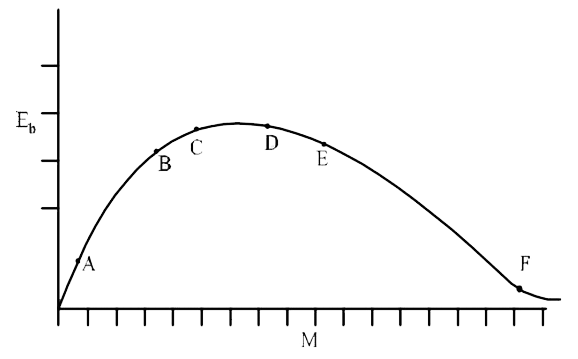The alongside is a plot of binding energy per nucleon Eb ,against the nuclear mass M,A,B,C,D,E,F correspond to different nuclei. Consider four reactions.
(i) A + B → C +ε (ii) C → A + B + ε
(iii) D + E → F + ε (iv) F → D + E + ε where ε is the energy released. In which reactions , is ε positive?

(i) and (iv)
(i) and (iii)
(ii) and (iv)
(ii) and (iii)
The correct Answer is:A
Step by step video & image solution for The alongside is a plot of binding energy per nucleon E_(b) ,against the nuclear mass M,A,B,C,D,E,F correspond to different nuclei. Consider four reactions. (i) A + B to C + epsilon (ii) C to A + B + epsilon (iii) D + E to F + epsilon (iv) F to D + E + epsilon where epsilon is the energy released. In which reactions , is epsilon positive? by Physics experts to help you in doubts & scoring excellent marks in Class 12 exams.
Updated on:21/07/2023Topper's Solved these Questions
Similar Questions

The above is a plate of binding energy per nucleon E0 against the nuclear mass M,A,B,C,D,E,F correspond to different nuclei Consider four reactions:
View SolutionIn Figure, DEFG is a square and ∠BAC=90 . Prove that (i) A G F ~ D B G(ii)AGF~EFC (iii) D B G ~ E F C(iv)DE2=BDxEC
View SolutionD, E, F are the mid-point of the sides BC, CA and AB respectively of △ABC. Then DEF is congruent to triangle.
(a)ABC
(b) AEF
(c) BFD, CDE
(d) AFE, BFD, CDE
View SolutionIf U={a,b,c,d,e,f,g,h}, find the complements of the following sets :(i) A={a,b,c} (ii) B={d,e,f,g] (iii) C={a,c,e,g} (iv) D={f,g,h,a)
View SolutionIf U={a,b,c,d,e,f,g,h}, find the complements of the following sets :(i) A={a,b,c} (ii) B={d,e,f,g] (iii) C={a,c,e,g} (iv) D={f,g,h,a)
View SolutionABCD is a parallelogram and E and F are the centroids of triangles ABD and BCD respectively, then EF=
(a)AE
(b) BE
(c) CE
(d) DE
View SolutionIn Figure, AD and BE are respectively perpendiculars to BC and AC . Show that: (i)△ADC~△BEC (ii)CA×CE=CB×CD (iii)△ABC~△DEC (iv)CD×AB=CA×DE
View SolutionLet f(x)=[x]cos(π[x+2]) where [ ] denotes the greatest integer function. Then, the domain of f is (a) xεR,x not an integer (b) xε(−∞,−2)∪[−1,∞) (c) xεR,x≠−2 (d) xε(−∞,−1]
View SolutionIn Fig. 4.101, AD and CE are two altitudes of ABC . Prove that AEF~CDF (ii) ABD~CBE
View SolutionIn Figure, ABCDE is a pentagon. A line through B parallel to AC meets DC produced at F. Show that:
(i) ar (ACB)=ar (ACF)
(ii) ar (AEDF)=ar (ABCDE)
View Solution
